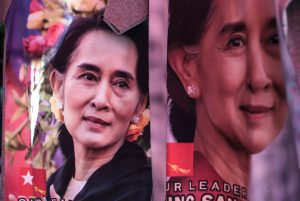Tens – perhaps hundreds – of thousands of people took to the streets in Myanmar on Monday, as protests against last week’s military coup continued to grow across the country.
On February 1, the military, or Tatmadaw, dissolved parliament, arrested State Counselor Aung San Suu Kyi and President Win Myint, and declared a one-year state of emergency, citing unproven allegations of voter fraud at last November’s election.
Myanmar citizens reacted with immediate outrage to the sudden termination of the political reforms that began in earnest 2011, which ushered in a significant degree of political liberalization – even as they preserved a central political role for the army.
In the days after the coup, the sun set to the ritual banging of pots and pans by Yangon residents from their balconies, while medical doctors and other government workers walked off the job in protest. On Saturday, these protests evolved into tentative street gatherings in Yangon, which grew on Sunday into a large protest that converged on the golden pinnacle of the Sule Pagoda in downtown Yangon – the scene of mass protests against military rule in 1988 and 2007.
Bearing images of Aung San Suu Kyi, and the red flags of her National League for Democracy (NLD) party, protesters chanted “Long live Mother Suu” and “Down with military dictatorship.” (Here’s a video taken at Sunday’s protests, with the pan-Asian three-fingered anti-authoritarian salute featuring prominently.) According to social media and local reports, protests also took place in other parts of the country, including Mandalay and Bagan.
In Yangon, Mandalay, and Naypyidaw, protests and strikes continued for a third straight day on Monday, featuring the blare of car horns, anti-coup chants, and the increasingly ubiquitous three-finger democracy salute. In Naypyidaw, water cannons were used to disperse protesters, but ran out of water and were prevented by crowds from leaving the scene. The protests continue to gain momentum, as people are further emboldened by the large gatherings. As the journalist Aye Min Thant tweeted on Monday, the country’s growing Civil Disobedience Movement “now consists of labor unions, students, teachers, doctors, lawyers, taxi drivers, and more on top of millions of other Myanmar people.”
The mounting protests came as the government choked off internet access on Saturday, plunging the country into a brief phase of digital darkness, before access was partially restored around 24 hours later. Social media platforms like Facebook continue to be blocked, although enterprising protesters have learnt to circumvent the controls using VPNs. The social media block is aimed at stopping information that could “damage the stability of the state and undermine the interest of the people,” according to a government directive issued on Friday.
Recent days’ events carry indelible echoes of past episodes of confrontation between the military and pro-democracy activists. On Saturday, 16 NLD parliamentarians elected at November’s election symbolically convened the parliament via Zoom, repeating what NLD members did following the election of 1990, the result of which was also annulled by the military. Similarly, Sule Pagoda, which sits on a large traffic circle in the center of downtown Yangon, has historically served as a rallying point for political protests, most notably during the massive uprising in 1988, and again during the 2007 “Saffron Revolution” led by Buddhist monks.
Yet the political ingredients are somewhat different in 2021. The reforms engineered by the military in 2011 wrought significant changes on Myanmar society. Myanmar transitioned to a civilian government that quickly ended pre-publication censorship and let private media organizations flourish.
One of the most important was the exponential improvement in communications. In 2012, only 1.1 percent of Myanmar’s population used the internet, according to the International Telecommunication Union, and mobile phone SIM cards were purposefully priced far beyond what ordinary people could afford. But in 2014, the price of SIM cards plummeted to 1,500 kyat (around $1.50) and access spread quickly. Within two years, nearly half the population owned cell phones – most of them cheap smartphones with internet access – giving activists a new ways of organizing resistance.
As I noted last week, young people who have grown up in the era of relative freedoms look increasingly reluctant to relinquish these freedoms without a fight. During Sunday’s protests, some people carried posters that read: “You fucked with the wrong generation.”
But none of this guarantees success for the protest movement. Much depends on how far the protests spread, and how the new junta chooses to react. At the moment, the generals appear, as in Thailand, to be playing the waiting game, hoping that the public’s anger burns itself out. But there’s also the possibility that as in 1988 and 2007, the current protests will continue to spread until they post a threat to the junta.
Protesters are not just calling for the reversal of the coup, the release of Aung San Suu Kyi and other detained NLD leaders, and the recognition of November’s election result; some are also demanding the repeal of the 2008 Constitution in order to remove the military from Myanmar’s politics once and for all. It’s hard to see the military backing down on either of these demands, and the fact that the military ended these past episodes of protest by shedding the blood of its own people suggests that the two sides are on a perilous collision course.

































